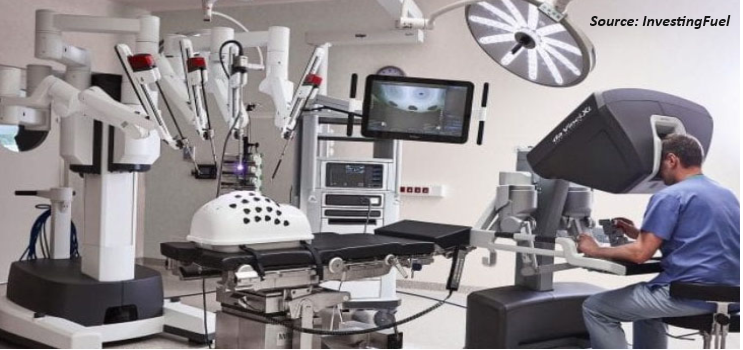
Internet of Medical Things (IoMT) Market by Component (Hardware, Software, and Services), by Application (Telemedicine, Medication Management, Patient Monitoring, Other Application), and by End User (Hospitals, Homecare, Clinics, Research Institutes, and Other End User) – Global Opportunity Analysis and Industry Forecast 2024-2030
Internet of Medical Things (IoMT) Market Overview
The global Internet of Medical Things (IoMT) Market size was valued at USD 92.54 billion in 2023 and is predicted to reach USD 419.44 billion by 2030 with a CAGR of 24.2% from 2024-2030.
The Internet of Medical Things (IoMT) also known as healthcare IoT is a network of medical devices and applications that connect to healthcare IT systems through online computer networks. These devices collect, transmit, and analyze patient data, enabling remote monitoring, diagnosis, treatment, and management of health conditions.
From wearable sensors to stationary medical equipment, these interconnected devices facilitate real-time healthcare delivery, improving patient outcomes and enhancing operational efficiency within healthcare organizations. This interconnected ecosystem enables healthcare providers to remotely monitor patients, intervene proactively, and optimize treatment strategies. By leveraging the IoMT, healthcare organizations further enhance operational efficiency, improve patient outcomes, and deliver personalized care, ultimately transforming the way healthcare is delivered and managed in the modern era.
Market Dynamics and Trends
The growth of the Internet of Medical Things (IoMT) market demand in health and medical industries is driven by increasing adoption of technology like sensor technology, connectivity and data analytics. An instance of this trend is the partnership between Koninklijke Philips N.V. and CoxHealth, a not-for-profit healthcare provider. They partnered to develop an internal virtual care solution with an aim of improving bedside care, bettering patient outcomes and improving staff satisfaction as well. This innovation utilizes CoxHealth’s knowledge in virtual care to incorporate advanced capabilities including AI-based clinical decision making, connected platform for simplified procedures, and insights derived from health records enabling continuous improvements.
Also, the rising focus on keeping data safe and private to protect patients' health info is driving the Internet of Medical Things (IoMT) market growth. A key example of this trend is Palo Alto Networks' new security service, Medical IoT Security. This tool is made to improve the safety of linked devices that are important for patient care in healthcare places. By working well with Palo Alto Networks' cloud-based security services including Advanced Threat Prevention and Advanced URL Filtering, this modern solution offers the best protection against threats. It also covers gaps in medical device safety within current IT and security plans by using direct, built-in tasks.
Moreover, the growing need for smart wearable devices, especially those that track health info in real time, is making the market bigger. For instance, in November 2022, Biostrap released a new device you wear on your wrist named Ethos. Ethos tracks ongoing raw PPG data, which is key for health research and looking after patients. This move is part of Biostrap's plan to focus more on the health market, aiming to better patient care with a focus on being precise and open to all. This trend highlights the potential for smart wearable devices to revolutionize patient care and research, and underscores the growing demand for these technologies in the healthcare industry.
However, the incorporation of Internet of Medical Things (IoMT) devices into existing healthcare infrastructure and processes is an intricate and time-intensive effort, which further hinders the Internet of Medical Things (IoMT) market expansion.On the contrary, the increasing preference of consumers for virtual interactions to enhance their health and well-being is poised to create significant opportunity growth for the market. For example, Amazon Clinic is a virtual health service that provides messaging and video visits for common health conditions. It offers convenient and affordable virtual care from licensed clinicians, with up-front pricing and treatment within hours, instead of days. This shift towards virtual care further meets consumer demands and represents a significant opportunity growth for the market in the healthcare sector.
Market Segmentation and Scope of Study
The Internet of Medical Things (IoMT) market report is divided on the basis of component, application, end user and region. On the basis of component, the market is categorized into hardware, software and services. The hardware segment is divided into wearable devices, stationary devices, implantable devices, and others.
Based on services, the market is further segmented into integration & deployment, consulting, and support & maintenance. On the basis of application, the market is classified into telemedicine, medication management, patient monitoring, and other application. On the basis of end user, the market is bifurcated into hospitals, homecare, clinics, research institutes, and other end user.
Regional breakdown and analysis of each of the aforesaid segments includes regions comprising of North America, Europe, Asia-Pacific, and RoW.
Geographical Analysis
North America dominates the Internet of Medical Things (IoMT) market share during the forecast period. This is attributed to factors such as the growing innovations and development towards technological advancement in hospitals and health clinics is driving the growth of the market. For instance, in February 2024, KORE and Medical Guardian collaborated to launch the first eSIM-powered medical alert device called the MGMini. This innovative technology aims to enhance healthcare support by providing uninterrupted 24/7 emergency response coverage. The device overcomes cell signal challenges and addresses healthcare access disparities by enabling electronic switching of service carriers for optimal connectivity.
Furthermore, the adoption of telemedicine and remote monitoring systems as the key factors are creating a massive opportunity in the North American market. Most of these technologies serve as the fundamental enabler of remote care programs – a concept that brings many benefits needed to transform healthcare in the region. For instance, in July 2023, a new membership program was created company in the U S for the SmartHeart telemedicine. These devices used to treat post- myocardial infarction (MI) patients. It is possible to take rhythm strip with 12 leads ECG and transmit results of the ECG directly to the healthcare professionals using Bluetooth. Furthermore, the device holds the 510(K) designations from the US Food and Drug Administration or the FDA in 2011 intended for remote patient monitoring.
On the other hand, Asia-Pacific shows substantial growth in the Internet of Medical Things (IoMT) market trends where the market is analyzed across India, Australia, Japan, and rest of the APAC region. It is based on the fact that the growing implementation of digital neuromorphic technology in their services is further driving the market.
For instance, in August 2023, TATA Elxsi and BrainChip, Inc (Australia based technology company) partnered to provide intelligent, ultralow-power solutions. The partnership aims to leverage BrainChip's first-to-market, fully digital, neuromorphic technology to provide intelligent and low-power solutions to demanding target markets such as healthcare and industrial automation.
Furthermore, rising need for improved patient care, enhanced healthcare outcomes, and a more efficient healthcare system in South Asian countries such as Japan, South Korea and Indonesia is propelling the demand for IoMT solutions.For instance, in March 2023, Fujitsu launched a new cloud-based platform for the healthcare sector in Japan, aiming to promote personalized healthcare and drug development. This platform allows users to securely collect and leverage health-related data to drive digital transformation in the medical field. It automatically converts medical data from electronic medical records to conform with the next-generation standards framework HL7 FHIR and securely aggregates health-related data.
Competitive Landscape
Various key players in the Internet of Medical Things (IoMT) industry includes Boston Scientific Corporation, GE Healthcare, Cisco Systems, Inc, IBM Corporation, Siemens Medical Solutions USA, Inc, Johnson & Johnson Services, Inc, Wipro Limited, Koninklijke Philips N.V., Microsoft Corporation, Baxter International Inc., and others. These market players are opting various strategies such as collaboration and product launches to maintain their dominance in the market.
For instance, in July 2023, GE HealthCare collaborated with Medanta to introduce a 24/7 remote and virtual service for ICU patients known as the Medanta e-ICU Command Centre. This innovative platform offers advanced consultation, care, and near-real-time monitoring of critically ill patients without the need to physically transfer them to a super-specialty hospital.
For instance, in September 2023, Koninklijke Philips N.V. launched its Virtual Care Management (VCM) solution, a robust telehealth platform designed to elevate patient involvement, enhance health results, and lower healthcare expenses. This innovative program provides tailored protocols for handling chronic ailments such as diabetes, hypertension, and COPD. By integrating connected devices and engagement resources within a secure, cloud-based system, it delivers personalized health guidance and valuable insights to empower individuals in managing their well-being effectively.
Key Benefits
-
The report provides quantitative analysis and estimations of the Internet of Medical Things (IoMT) market from 2024 to 2030, which assists in identifying the prevailing market opportunities.
-
The study comprises a deep-dive analysis of the current and future Internet of Medical Things (IoMT) market trends to depict prevalent investment pockets in the market.
-
Information related to key drivers, restraints, and opportunities and their impact on the Internet of Medical Things (IoMT) market is provided in the report.
-
Competitive analysis of the players, along with their market share is provided in the report.
-
SWOT analysis and Porters Five Forces model is elaborated in the study.
-
Value chain analysis in the market study provides a clear picture of roles of stakeholders.
Internet of Medical Things Market Key Segments
By Component
-
Hardware
-
Wearable Devices
-
Stationary Devices
-
Implantable Devices
-
Others
-
-
Software
-
Services
-
Integration & Deployment
-
Consulting
-
Support & Maintenance
-
By Application
-
Telemedicine
-
Medication Management
-
Patient Monitoring
-
Other Applications
By End User
-
Hospitals
-
Homecare
-
Clinics
-
Research Institutes
-
Other End User
By Region
-
North America
-
The U.S.
-
Canada
-
Mexico
-
-
Europe
-
The UK
-
Germany
-
France
-
Italy
-
Spain
-
Denmark
-
Netherlands
-
Finland
-
Sweden
-
Norway
-
Russia
-
Rest of Europe
-
-
Asia-Pacific
-
China
-
Japan
-
India
-
South Korea
-
Australia
-
Indonesia
-
Singapore
-
Taiwan
-
Thailand
-
Rest of Asia-Pacific
-
-
RoW
-
Latin America
-
Middle East
-
Africa
-
Key Players
-
Boston Scientific Corporation
-
GE Healthcare
-
Cisco Systems, Inc
-
IBM Corporation
-
Siemens Medical Solutions USA, Inc
-
Johnson & Johnson Services, Inc
-
Wipro Limited
-
Koninklijke Philips N.V.
-
Microsoft Corporation
-
Baxter International Inc.
REPORT SCOPE AND SEGMENTATION:
|
Parameters |
Details |
|
Market Size in 2023 |
USD 92.54 Billion |
|
Revenue Forecast in 2030 |
USD 419.44 Billion |
|
Growth Rate |
CAGR of 24.2% from 2024 to 2030 |
|
Analysis Period |
2023–2030 |
|
Base Year Considered |
2023 |
|
Forecast Period |
2024–2030 |
|
Market Size Estimation |
Billion (USD) |
|
Growth Factors |
|
|
Countries Covered |
28 |
|
Companies Profiled |
10 |
|
Market Share |
Available for 10 companies |
|
Customization Scope |
Free customization (equivalent to up to 80 working hours of analysts) after purchase. Addition or alteration to country, regional, and segment scope. |
|
Pricing and Purchase Options |
Avail customized purchase options to meet your exact research needs. |




 Speak to Our Analyst
Speak to Our Analyst


































